The Fallen-Army (in chronological order)
Lynton Woolmer WHITE (died 1914 in Nery, France)
Lieutenant, 1st (King’s) Dragoon Guards,
First to die was one of the officers, Lynton Woolmer White, elder son of Woolmer White, of Salle Place in Norfolk, and Southleigh Park, in Hampshire. Lynton was educated at Cheltenham College, and Trinity College, Cambridge. He was appointed to the King’s Dragoon Guards on 7 May 1905 (a crack regiment) and joined them in India. A Lieutenant in March 1910, he married Dorothea in June 1911, a girl he met in India. The wedding was in Kensington, during one of Lynton’s leave periods.
Lynton was back out in India in time for the Delhi Durbar, when the King Emperor (George V) was crowned with the Imperial State Crown. The King’s Dragoon Guards formed his escort. He presented them with a special medal.
When war was declared, (4 August 1914) Lynton was again home on leave! The War Office directed him to join the next most prestigious cavalry regiment, the Second Dragoon Guards (the Queen’s Bays) at Aldershot. When ready to leave for France, they were inspected by her Majesty Queen Mary, with her husband.
The regiment sailed 16 August from Southampton to Le Havre, to join the British Expeditionary Force (BEF). They fought at Mons and joined the long retreat south to Paris. The Bays were in the rear-guard, together with “L” Battery, Royal Horse Artillery.
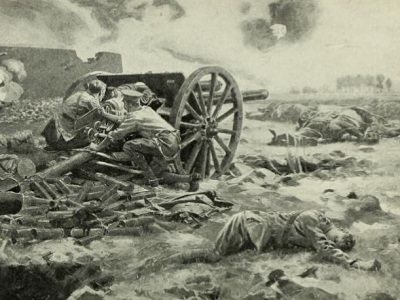
In the early morning of 1 September 1914, as the rear-guard sought to leave the little village of Nery, they came under fire from German horse artillery.
“L” Battery brought 3 guns into action but was soon reduced by German fire to one gun, served by the Battery second-in-command, Captain Edward Bradbury, the Battery Sergeant-Major, George Dorrell and Sergeant David Nelson. Bradbury was badly wounded and died in Nery. The other 2 men kept firing till all their ammunition was gone (all 3 received VCs).
British reinforcements arrived. A group of the Bays, including Lynton, drew swords, and charged across the valley towards the German guns. The Germans retreated, leaving 8 of their guns (4 more were captured later). They took 78 prisoners.
The British retreat continued. Lynton and others, severely wounded, were left at the Chateau de Baron, some 10 miles south of Nery. Lynton died of his wounds in the Chateau on 3 September 1914.
Edward Charles HUTCHINGS (died 1915 at Aubers Ridge)
Private L/10412, 2nd Battalion, Royal Sussex Regiment
With the 2nd Battalion, Royal Sussex Regiment, Edward Charles Hutchings was mobilised in 1914, and as part of Sir John French’s British Expeditionary Force (BEF), fought at Mons, retreated to the Marne, fought on the River Aisne and at Ypres. In 1915 the BEF were entrenched, facing the Germans, from Ypres to Neuve Chapelle.
The Germans had built excellent trenches, with deep dug-outs (some pumped dry by electricity), steel plate inserts in the parapet, and a number of stout concrete pill-boxes (still visible today). Critically, they established machine-gun pits ahead of their wire, with very large arcs of fire.
General Joffre suggested to Sir John French a major attack at the point where the two armies met, to take German pressure off the Russians on the Eastern Front. The French on their right would take Vimy Ridge, the BEF the much lesser heights of Aubers Ridge (Lat.50.59552 Long.2.825528 for Aubers village centre if you Google it!)
The 1st British Army (Haig) planned a two-pronged attack. The northern group included both cyclists and cavalry, intended to exploit the hoped-for break-out. The 2nd Battalion Royal Sussex were in the southern group, alongside Indian troops.
The attack, originally planned for 8 May, was postponed by the French for 24 hours. By the time the decision came down from General Haig, the first wave, including the Royal Sussex, had already moved into the front line. They had an anxious wait!
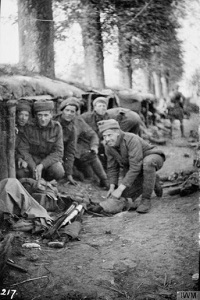
The sun rose at 4.06am on the 9 May. At 5am, the attack was preceded by a 40 minute bombardment by 600 artillery weapons. The majority of the shells were shrapnel, intended to hit troops in the open, but ineffective in cutting wire, or disturbing trenches.
Fewer than 8% were high explosive. Many of the guns had worn barrels, and could not be laid accurately, shells often falling short. As the Germans were quick to spot, there were many unexploded shells (‘duds’). One German regiment was to report ‘duds’ of apparently American manufacture, filled not with high explosive, but with sawdust!
At 5.40am, the barrage lifted, and our troops rose from their trenches. They were met by a hail of machine-gun fire. Two men in each platoon of the Royal Sussex carried a wooden bridge, to assist troops across the stream that ran through ‘no man’s land’. Those that reached the German wire found it uncut, and were mown down, or forced to lie down. The Royal Sussex were ‘virtually annihilated’, losing 551 casualties.
The attack having failed, a second attack was ordered. At 3.57pm the Black Watch went forward behind their bagpipes. Other troops, intended to attack, were delayed by the dead and wounded in the British approach trenches. Some 50 of the Black Watch did reach the German parapet but were later killed. Corporal John Ripley, the first to get there, was awarded the VC.
The order to retire was given during the night. The Germans counter-attacked at 2.30am on 10 May. General Haig met the Corps commanders later that day, with the intention of ordering a further attack. The Corps commanders emphasised that the wire was still largely in place, and that there were no more shells for the artillery. Attack was abandoned. (Sir John French was soon to receive an order from the War Office to give up 20,000 shells, 20% of his total reserve, for use in Gallipoli).
Thus ended the Battle of Aubers Ridge, with nearly 12,000 officers and men as casualties.
The Aftermath
Sir John French, in his report, blamed the failure on the lack of high explosive shells. He passed this conclusion on to the Military correspondent of the Times newspaper and sent two officers to London to brief the Conservative leader, Andrew Bonar Law, and the Liberal Cabinet minister, David Lloyd George. The Times article came out on 14 May. The Daily Mail took up the story. Two days later (16 May), Admiral ‘Jackie’ Fisher, First Sea Lord, resigned over the Dardanelles campaign. Thus, on 19 May, the Prime Minister Herbert Asquith was forced to form a coalition with the Conservatives. Winston Churchill was replaced as First Lord of the Admiralty by Arthur Balfour, a former Conservative Prime Minister. Lloyd George was appointed to the new post of Minister of Munitions. The first women munition workers started work on 1 June. By December 1916, Lloyd George was Prime Minister.
Edward Hutchings, and over 13,400 others who died in 1914-1915, with no known grave, are remembered in the Le Touret (CWGC) memorial, some 7 km to the west of Aubers village.
Battle of The Somme
The Battle of the Somme (1 July – 18 November 1916) was a joint operation between British and French forces intended to achieve a decisive victory over the Germans on the Western Front. Further information about the battle can be found on the Imperial War Museum website. Rowlands Castle lost 3 men in this campaign.
Tom PIGGOTT (died 1st July 1916)
Private, 1st Battalion Hampshire Regiment
James YALDEN (died 15th September 1916)
Lance Corporal, 15th (Service Battalion) Hampshire Regiment
William CONDUCT (died 13th October 1916)
Private, 2nd Battalion Hampshire Regiment
Preparations for Battle
Haig brought forward 25 infantry divisions, 3 cavalry divisions. The French had 14 infantry divisions, and 4 cavalry divisions. The British had 808 field guns (3.5 inches calibre), 128 60-pounders (5-inch), 410 howitzers, and 120 larger guns, the French rather more. Vast dumps of ammunition were made. Sappers tunnelled forward, to mine the German line, to bring troops and trench mortars into No Mans’ Land, and to counter German mining (read Birdsong by Sebastian Faulks, for a good account of this underground war).
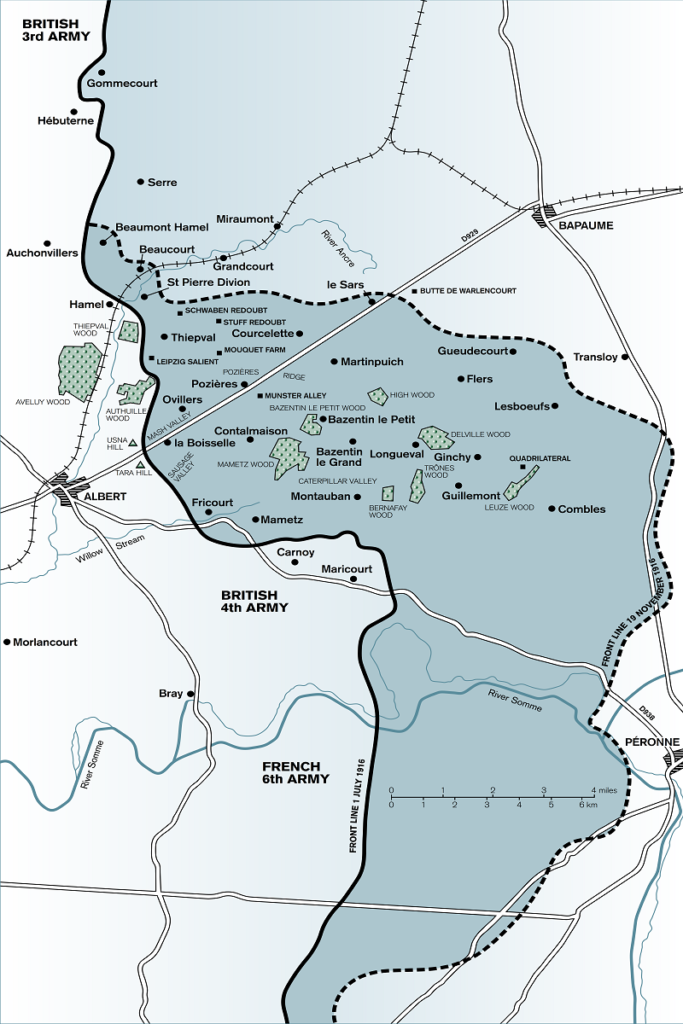
The German lines shown on this map, are very much those taken up in 1914 following their retreat from the Marne, but in 2 years they were much improved. Critically, they provided ‘mined dug-outs’ (i.e. dug by miners) up to 50 feet below ground, with up to 4 wide stairways to the trenches.
Troops and weapons there were safe from all but the largest calibre shells. Multiple exits generally allowed the troops to man the trenches, despite damage from our artillery.
The preliminary bombardment of the German trenches and artillery started on 24 June. Cutting of the German wire was largely given to the field guns, firing shrapnel shells, which had a very small bursting charge. These proved of mixed effectiveness. On 28 June, mist and showers caused the attack to be deferred by 2 days to the morning of 1 July. Heavy gun and howitzer ammunition, difficult to re-supply, had therefore to be conserved for that attack.
The First Day (1 July 16)
At 6.25 am the final bombardment of the German lines started. The attack was planned for 7.30am. A mine exploded at 7.20, alerting the Germans, who responded almost immediately with artillery, and then with machine-guns (7.25), as their men came up from their deep dugouts. More British mines were fired at 7.28am.
The 1st Hampshires were part of the 4th Division, on the left of the British line, near the village of Serre. The first wave of infantry, including men of the East Lancashires, was pinned down in No Mans’ Land. The Hampshires (led by Lt.Colonel the Hon. Laurence Palk carrying a swagger stick), came forward as part of the second wave at 7.40am, to suffer many casualties. Trenches and No Mans’ Land were crowded with dead and wounded. The 4th Division was declared ‘unfit for further offensive action’ by its CO at 3pm.
The 4th Division suffered 5,754 casualties (killed and wounded) on this one day, sadly including Tom Piggott, a brigade commander and 6 battalion commanders killed, and 3 battalion commanders wounded.
Pompey Pals
The 15th (2nd Portsmouth) battalion, Hampshire Regiment was raised In Portsmouth on 5 April 1915, and moved from Aldershot to France in May 1916. They took part in their first full-scale battle on 15 September 1916 (the battle of Flers-Courcelette).
Haig had been keen to include tanks in the Somme campaign. This battle was the first in which they were employed. 49 Mark 1 tanks were available, of which only 36 reached their start line. Despite losses from artillery and breakdown, they proved effective. The Portsmouth Pals marched up the main street of Flers behind a tank (D6 Lieutenant Arnold), which destroyed 3 German machine guns. The Germans retreated. Haig ordered another 1,000 tanks!
Lance-Corporal James Yalden died in this attack. After the war, the villagers of Picardy rebuilt their homes, aided by the Treaty of Versailles, and by the British League of Help, in which Portsmouth ‘adopted’ Flers.
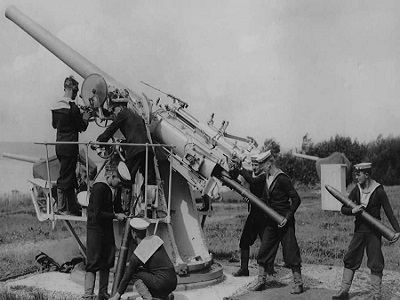
The tank gunners manning their long-barrelled 6-pounders were trained in Portsmouth by the Royal Naval Gunnery School, Whale Island. Picture from The News, Andrew August collection.
Frank WEEKS (died 2 December 1917 at La Vacquerie)
Private 267122, 2/6th Battalion (Territorial), Gloucestershire Regiment
Frank and the Tanks – The End of the Affair 1917
Frank Weeks fought and died at Cambrai, in France, in the first battle ever, where tanks were used successfully.
Frank was born in Havant. He volunteered to join the army in response to General Kitchener’s call. He signed up in Portsmouth but was sent to the Gloucestershire Regiment (commonly referred to as the Glorious Glosters). Frank’s battalion, the 2/6th (Territorial) infantry battalion, trained on Salisbury Plain, and went to France on 24 May 1916.
Battle of Fromelles, Northern France, 19-20 July 1916
Here, as part of the 61st Division, Frank took part in the battle, together with the 5th Australian Division. Preparations for the attack were rushed, both divisions lacked experience in trench warfare, and the German defence outnumbered them 2:1.
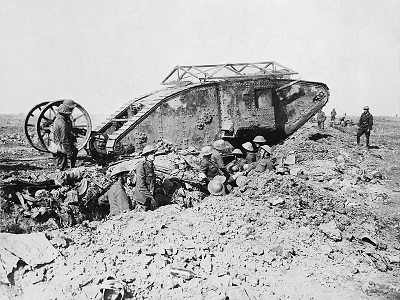
Attacking on a 2-mile front, they fought over much the same ground as another villager, Edward Hutchings, who died at Aubers Ridge in 1915. In this one attack, the Australians lost 5,533 men killed and wounded. Frank’s Division lost 1,547 men, and thereafter was not employed in an attacking role.
The Battle of Fromelles was fought in support of British major action on the Somme (1 July – 18 November 1916). The first tanks were used here, from September 1916. Only 49 Mark 1 tanks were available. Useful lessons were learnt, but tank numbers were too few to significantly affect the battle. (Photo IWM Q2486 by Ernest Brooks)
Battle of Cambrai 1917
General Haig was persuaded by the reports from the Somme that the tank did offer a solution to the stalemate of the trenches. He invited General Byng to prepare a plan for a major raid, incorporating large numbers of the Mark IV tank then under development.
Byng got together with General Sir Hugh Ellis, commanding the Tank Corps, and Major J F C Fuller, the Tank Corps’ chief-of-staff (Fuller, later Major General, was quick to grasp the capabilities and limitations of the early tanks). They agreed –
- Any preliminary bombardment should be kept short, to avoid damage to the ‘going’ for the tanks.
- The supporting infantry should keep close behind the tanks.
- The tanks would crush barbed wire barriers. The infantry would walk through following the imprint of the tank tracks.
- To aid crossing enemy trenches, each tank would carry a large bundle (fascine) of firewood, to be dropped in the trench.
The attack would be against the major road junction of Cambrai, some 8 miles behind the front line (6 miles wide). Overall, General Byng brought together 6 infantry divisions (including Frank Weeks’ 61st), 5 cavalry divisions, 474 tanks (including fighting tanks, gun carriers, supply tanks, and a few wireless tanks), over 1,000 field guns, and 14 squadrons of the Royal Flying Corps.
The attack was planned to be launched on 20 November 1917. Tanks were gathered well behind the lines, prepared for action, and brought forward by 36 trains. From the railhead, tanks moved by night to holding areas and then moved to their launch position on the night before the attack.
Shortly before the tanks advanced, General Sir Hugh Ellis climbed into tank HILDA, in the centre of the front, waving the now famous banner with colours of brown, red and green (Through mud and blood to the green fields beyond!).
The attack was a great success, with penetrations up to 5 miles on the first day. The wireless tanks reported progress to General Byng. When the news reached London, the Government ordered the church bells to be rung in celebration.
German resistance hardened. Frank’s 61st division, initially in reserve, marched forward through the captured trenches to the green fields, to relieve their hard-pressed colleagues on the right of the line, just as the German counterattack started (30 November).
Frank died whilst defending a very temporary trench line in the village of La Vacquerie, on 2 December 1917. On the following day the remains of his battalion were driven from the village. On 4 December a general order to withdraw was given. On 7 December withdrawal was complete, and snow fell.
The Reckoning
Britain lost 44,207 men dead and wounded (including 6,000 POW), 103 field guns and 55 heavier guns, and also lost most of the tanks! The Germans lost 45-53,000 dead and wounded (including 10,500 POW), 142 guns and 350 machine guns.
There was no net gain or loss of territory.
Remembrance
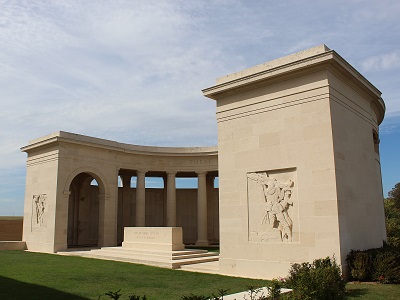
Frank Weeks’ name is recorded on the CWGC Cambrai memorial at Louverval. The memorial lists the 7,048 missing soldiers of the United Kingdom and South Africa who died at the Battle of Cambrai and have no known graves.
The memorial was unveiled on 4 August 1930. (Photo by René Hourdry)